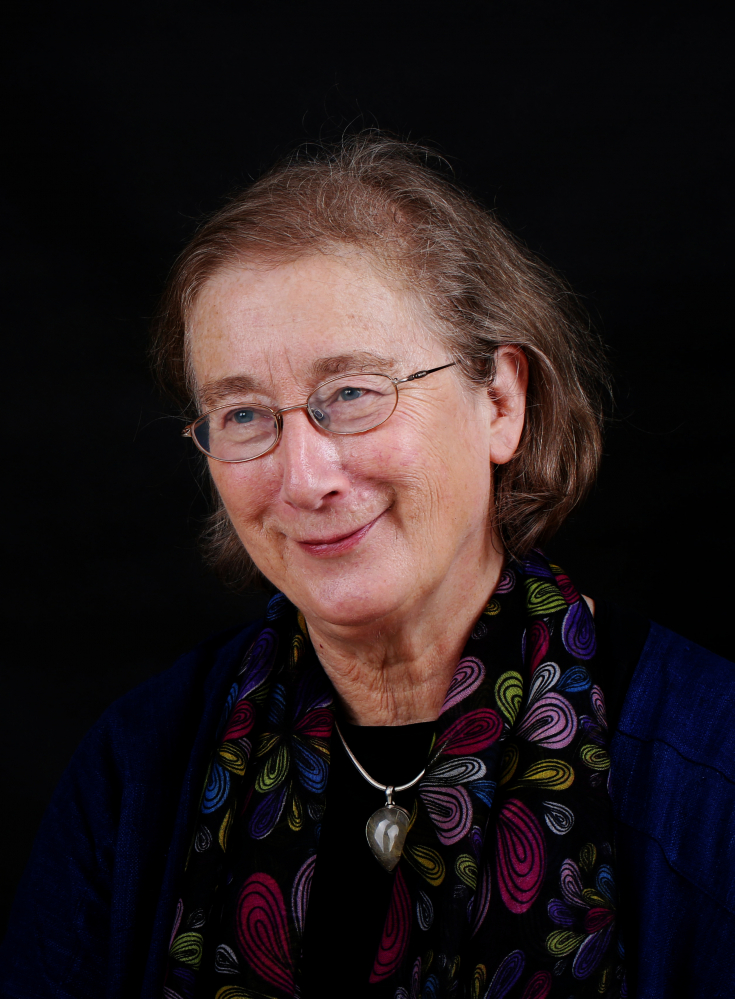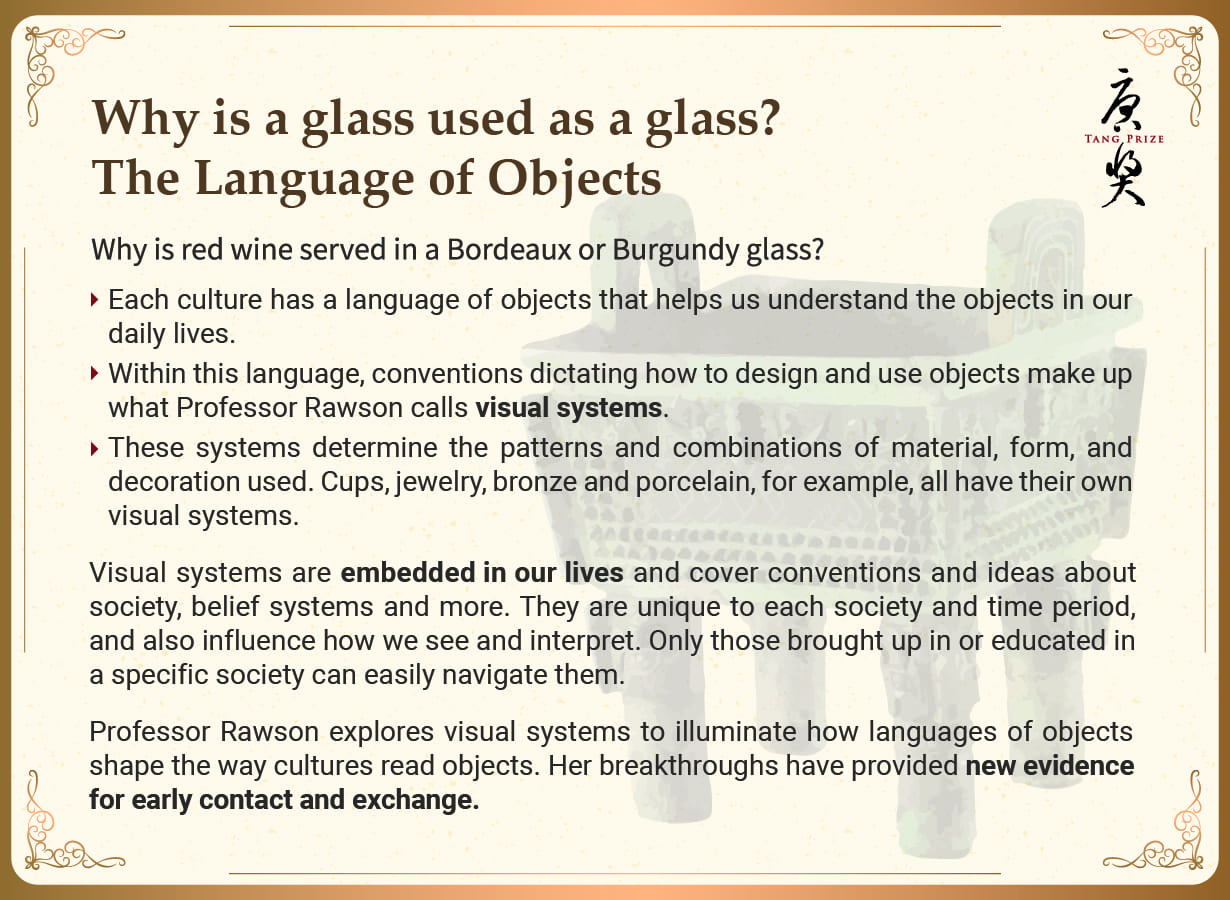Specializing in Chinese material culture, Professor Dame Jessica Rawson is one of the most important scholars of Chinese art and archaeology. Her original and trailblazing achievements in the archaeology of China and Inner Asia, particularly of the relationship between ancient China and its mobile and semi-sedentary neighbors in the mountains, as well as in the steppe and semi-desert landscapes, which surround the Central Plains, have revolutionized and broadened our understanding of early contact and exchange between the East and the West. Recently, Professor Rawson’s work on the introduction of horses from Mongolia to China has led to new ideas on the origins of the Silk Road. Specifically, her expansive and perceptive understanding of Western classical and ancient Chinese visual systems offers concrete evidence of communication and exchange between ancient China and the Western world through the mediation of their Eurasian neighbors.
Put in the context of Sinology, a study often thought of as bound to the written word, Professor Rawson’s contributions bring to the forefront an entirely different realm of understanding. Her contributions show that, besides the written word, there is another talent and another craft to read the art and artifacts of the world to interpret and understand distant and ancient societies, with their beliefs, interactions, and connections. Professor Rawson is a master of this craft, with an unparalleled visual learning built over a long career. Her talent and her knowledge have given a voice to the mute world, things that were earlier simply taken from the earth clothed only in their aura.
Leading breakthroughs in material culture and art history
During her long career at the British Museum, Professor Rawson worked and collaborated extensively with museums and archaeological teams throughout Europe and Asia, through which she gained an unparalleled familiarity and in-depth understanding of ancient artifacts spanning the Eurasian continent. This extensive mastery of a broad range of material culture is the foundation on which her scholarship is grounded.
Building upon the recognition that in Western architecture that there is no real division between art and ornament, she has suggested that we gain new understanding if we pay attention to, identify and appreciate the visual systems that are created by form and ornament jointly, not just in Western architecture, but in Chinese bronzes and ceramics or Siberian gold belts and Islamic manuscript illustration. Professor Rawson further points out that, while the “messages” of art forms change over time and evolve with belief systems, ornament and design have strong traditions that can be readily passed down, being rediscovered and reworked, from generation to generation through discipleship. Such visual systems are often taken over in new regions, leaving behind their former messages and gaining thereby new associations, as when Mediterranean forms of classical architecture were taken over in Western Asia, then merged along the Silk Road with Buddhism, finally forming the structure of the design of the Buddhist caves in Central China.
Such journeys take place both across Eurasia as well as within ancient China. When examining Shang and Zhou ritual bronzes and jades, Professor Rawson drew attention to the key roles of sets or groups of ritual vessels in identifying their dates and their regions of origin. Moreover, changes in the numbers of such vessels in a set and the design of their shapes and integrated ornament reveal important social and religious changes. She further points to designs modelled on antique styles in the decoration of Shang and Zhou bronzes and also portrays how local areas incorporated regional features and characteristics in their own versions. In looking at Chinese bronzes, Professor Rawson has made further contributions in elaborating the notion of a visual or ornamental system, which she defines as a whole complex, comprising an array of components, with a number of basic elements that can be learned, used, and assembled by the craftsman following rules governing the ways in which they are combined. Professor Rawson uses these ideas to explain that a visual system can be transplanted to areas far from its origins, helping us to identify and explain connections and relationships over large areas.
Building upon her expertise in the study of ornamental systems, Professor Rawson’s acclaimed Chinese Ornament: the Lotus and the Dragon illustrates in detail the journey of a particular visual system throughout Eurasia—the lotus and dragon, one of the most influential and prevalent floral and animal decorative motifs throughout the world. Although such Chinese motifs were widely used in the West from the fifteenth century, Professor Rawson uncovered the much more ancient sources originating in the Mediterranean world during the period of Alexander the Great. These elements of the ancient Mediterranean ornamental systems were introduced to ancient China through the transmission of Buddhism across Central Asia. Chinese motifs, with the lotus as representative, then spread westward with the Mongolian conquest of Eurasia, and also through silk and porcelain exports to India, Central and Western Asia, becoming decoration in Iranian and Central Asian architecture. She has thus revealed how cultural exchange between East and West flowed in a circular fashion rather than in a unidirectional straight line. Professor Rawson’s explorations also examine the concepts, beliefs, and customs that underpin the emergence of these creations in each region.
Illustrating profound changes in cosmology, burial culture, and afterlife beliefs
Professor Rawson in her extensive studies of Chinese tombs focuses on the changes in the forms and connotations of burials from the Shang and Zhou to the Qin and Han dynasties, using archaeological excavations to demonstrate profound changes in material culture and in beliefs about the afterlife. Bridging the gap of understanding between Western and Chinese conceptions, she delves into the philosophical realm to consider how ancient perceptions of the concept of “images” differs from ours today, and how these beliefs relate to burial practices.
Ancient burials in central China provided a complete afterlife world for the dead. Shang and Zhou period vertical shaft tombs were accompanied by bronze and jade artifacts, which not only provided the dead with objects for ritual and status, but also with weapons and carriages for war. Many major changes occurred with the Qin. The elaborate burial of the First Emperor, Qin Shi Huangdi, not only contained an army of terracotta warriors, but also stables, carriages, court officials, wrestlers, concubines, and images of the heavenly bodies, making the tomb not an image of a universe, but actually creating this universe for the afterlife of its occupant. To these revolutionary changes, the Han aristocracy, added new forms of tomb, as horizontal, not vertical, dwellings for the afterlife and replaced sets of fine bronzes with lacquer vessels and with new types of jade, as forms of armor. These changes in burial objects reflected changes in attitudes and beliefs about death. Additionally, in the Han period, the use of stone for tombs, or the excavation of mountains for stone chambers all suggest a connection between Han China and Central Asia and Iran. In Iran, stone was preferred for sculpture and architecture, and tomb structures were also carved into mountains. In a sense, one can say that China had already entered early stages of “globalization” during the Qin and Han dynasties.
Furthering exchange and understanding of Eastern and Western art, culture and scholarship
In Professor Rawson’s academic career, there is no such thing as pure research. Starting out as a museum curator, she has long been both a practitioner and an academic, and the impact of her curated exhibitions has long been evident to all. Even after leaving the British Museum for the University of Oxford, she continued to present the diversity of Chinese culture to the public through enlightening exhibitions. One of her most exciting, China: The Three Emperors, 1662-1795, held at the Royal Academy of Arts from 2005 to 2006, took us back to imperial China, to the reigns of three of the most powerful Qing emperors, to explore the artistic and cultural riches of this period and their vivid connotations.
At the University of Oxford, Professor Rawson has expanded the study of Chinese culture and civilization both on and off campus. She has organized numerous field trips to Mongolia, Siberia, and Central Asia with Chinese scholars. From 2011 to 2016, funded by the Leverhulme Trust, she collaborated with Chinese scholars and led a major transnational research project titled, “China and Inner Asia: Cultural Exchange that Transformed China (1000-200 BC)” to investigate newly excavated sites and artifacts to study the interaction of northern China with the Mongolian and South Siberian Steppe. On campus, she has contributed to the importance of Chinese archaeology by facilitating academic exchanges between scholars from around the world and by nurturing students of various cultural backgrounds, many of whom have become leading scholars in the field of Chinese art and archaeology. She served as the first female Warden of Merton College from 1994 to 2010 and Pro-Vice-Chancellor of the University of Oxford from 2006 to 2010. Of particular note is her support and contribution to furthering Sinological research at Oxford. She bid and received a ten-year grant (2002-2012) to support the development of the study of contemporary China, which enabled the appointment of two senior and two junior academic positions, leading to the expansion of posts in the study of China. This was one of the moves that contributed to the foundation of the University of Oxford China Centre in May 2008.
Overall, Professor Rawson demonstrates tireless dedication and ingenuity in promoting exchange and the development of the field. Her work is characterized by a wide vision and has transformed the discipline while greatly increasing the public’s awareness of the uniqueness of Chinese cultures, leaving an indelible mark.
When it comes to recognition, Professor Rawson’s career has been marked by honors. She is a Fellow of the British Academy and was made a Dame Commander of the Order of the British Empire in 2002 for her contribution to Oriental Studies. In 2012, she was elected to the American Academy of Arts and Sciences as an International Honorary Member and received the 2017 Charles Lang Freer Medal for her lifetime work in Chinese art and archaeology. And now, we award the 2022 Tang Prize in Sinology to Professor Rawson for her remarkable contributions that created a new dimension in the study of Chinese art and archaeology, deepening our understanding of the growth of Chinese civilization.

.jpg?1708161055397)
.jpg?1708161099991)

.jpg?1708161134463)
.jpg?1708161142264)
.jpg?1708161152534)
.jpg?1708161159450)
.jpg?1708161166562)
